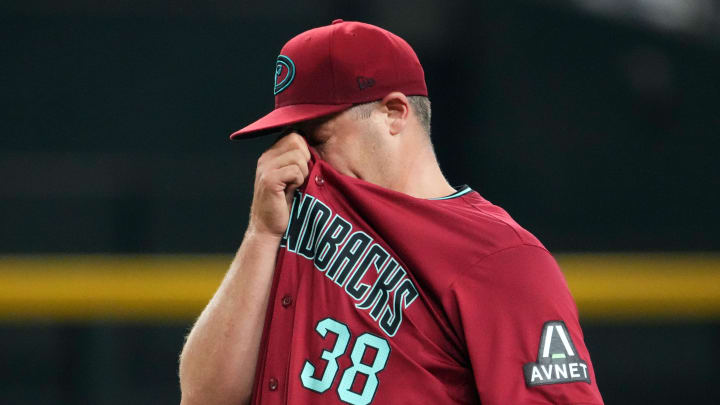Breaking Down the Diamondbacks' Blown Saves

There is no doubt that the Arizona Diamondbacks bullpen as a whole has ranked below average in the 2024 season year-to-date. The team reliever ERA of 4.49 ranks 25th in MLB, while their 4.18 FIP ranks 19th.
There are other metrics that point towards below average production from the bullpen as well. WPA, or Win Probability Added, is a stat that measures the team win probability before and after each at-bat and adds up those results. The D-backs' -0.51 ranks 24th.
And of course good old save percentage is an indicator as well. The D-backs rank 23rd in MLB with a 57% save conversion rate (25 for 44). League average is 63%. There is a problem with that measurement however. That includes all save opportunities that occur prior to the ninth inning. A pitcher can be charged with a blown save prior to the ninth, but he can't be credited with a save.
They can be credited with a hold however. A hold is similar to save, in that the reliever protects a lead of three runs or less, but prior to the ninth inning. A "True Save Percentage" therefore is looking at the conversion rate of Saves + Holds, divided by total save situations.
Unfortunately for the D-backs, their ranking in that stat does not fare much better. The MLB TS% is 83.1%. Arizona still ranks 23rd, with a 79.4% success rate.
For further context, the Guardians are the best in MLB with 90.% TS%, and the Reds are the best in the NL with 89.8% conversion rate. The White Sox are the worst in MLB, with 70.1%. The Rockies are the worst in the NL with 75%
Beyond all these rankings however, it's important to break down exactly what's happening on a game by game basis. The first thing I wanted to know, was how many of the Diamondbacks' blown saves occurred in the 9th inning or later.
Turns out, the D-backs have had 32 save chances in the ninth inning. They've converted 25 of them and blown seven, for a 78% success rate. You might often hear someone say or write "If only the D-backs didn't blow those saves they'd have seven more wins."
While technically true, that's not a realistic way to look at it. All teams blow saves in the 9th inning from time to time. If the D-backs had three fewer blown saves and were 28 for 32, that would be an 88% success rate, which is very good.
So it's fairer to say that ninth inning meltdowns have probably resulted in the D-backs recording three fewer wins than they should have. Of course in such a tight race, those three missing wins could still be the difference between booking flights to cities hosting playoff games, or booking tee times.
There is another important factor here. Of the seven blown saves, five of those games went to extra innings, and they lost all five. Only two of those games were walk-off losses on the road (Paul Sewald July 2nd in LA and July 5th in San Diego). So the team had a chance to pull at least a couple of those games out of the fire and were unable to do so.
What about the 12 blown saves that happened prior to he 9th inning? Well, the D-backs are 7-5 in those games, .580 W%. For example Ryan Thompson has been charged with five blown saves. But the D-backs won four of those games. Kevin Ginkel has two blown saves in the 8th inning. The team won one of those games in a walk-off, and lost the other in extra innings.
With the turmoil surrounding the closer position in the D-backs bullpen, it may be difficult for the team to improve their ninth inning save percentage. Torey Lovullo has said Paul Sewald has a delivery problem causing his lack of command and control. But he also has lost velocity, and he had precious little of that to give in the first place (from 92.5 down to 91).
The D-backs bullpen was a disaster last year prior to Sewald's arrival. The committee approach, or attempts to ride the hot hand, just never worked out. Were it not for the Sewald trade, the D-backs don't make the postseason, let alone advance to the World Series.
But that was then and this is now, and in the now, the season hangs in the balance. The Diamondbacks are back to square one without a reliable closer to take over the ninth inning.
Could one of A.J. Puk, Ginkel, Thompson, or some kind of effective a committee emerge? Will Sewald recapture the magic? These are questions that can only be answered on the field. Stay tuned.
